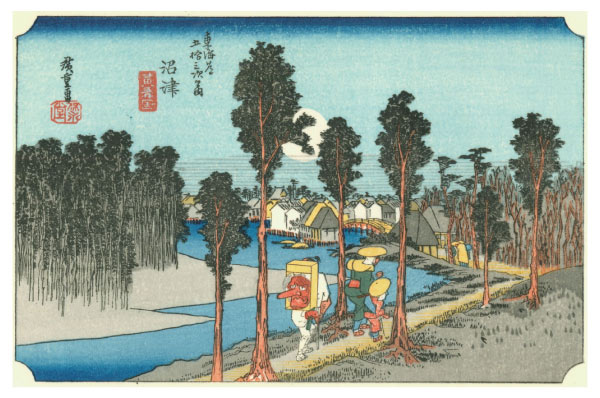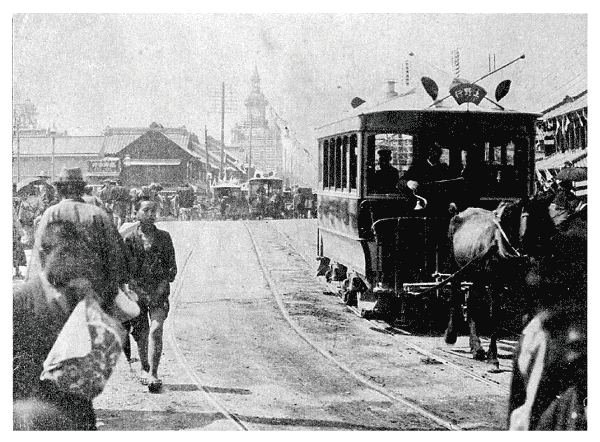History
Japan is a country comprised of four major islands and numerous minor islands. It is configured as a crescent shape
and situated to the east of the Asian continent in the Northwestern Pacific Ocean. Of its 378,000 square km of land,
about 70% is comprised of mountainous terrain. It is inhabited by more than 120 million people.
It is a country that has achieved harmony between its traditional culture from ancient eras and its modern society
with advanced technology. Yet, Japan’s fascinating natural environment is one that changes from season to season.
The history of land transport in Japan began over two thousand years ago and can roughly be categorized into the
following four eras: 1) Age of People and Nature (ancient times until the Meiji Restoration in 1867), 2) Age of Modernization
(from the Meiji Restoration until the 1950s), 3) Age of High Efficiency Networks (from the 1950s to the
present day), and 4) Age of Optimal Maintenance and Management for Maximum Utilization of Existing Roads.
l. Age of People and Nature (Ancient times until the Meiji Restoration in 1867)
l) The Ancient Foundations of Modern Japan
The oldest written record of roads in Japan appeared in a
Chinese history book from the 3rd Century called Gishiwajinden.
At that point in time, Japan was in the process of
unifying the country under the Yamato Dynasty. People
travelled on foot or horseback for hundreds of years until the
Meiji Restoration, when Japan opened its doors to the
modern nations of the West late in the 19th century, which
resulted in modern conveniences becoming available and
then prominent in Japan.
Unlike in China and the European countries, horse-drawn
carriages never fully evolved in Japan. The historical lack of
use of horse-drawn carriages could be due, in part, to the
country’s terrain which is mostly mountainous and
criss-crossed by numerous creeks and inlets.
After the Reformation of the Taika Era (645 C.E.), an elaborate
central government system, characterized by emerging
administrative and judicial institutions, was established. A
new road network was developed at this time that
connected Honshu (the largest island) to Shikoku (the
smallest of the four main islands) and then continued all the
way down to Kyushu (the southernmost and third largest
island).
This nationwide public road network was called “Seven
Roads”, and was composed of Tokaido, Tosando, Hokurikudo,
San-indo, San-yodo, Nankaido, and Saikaido (‘-do’ in
Japanese means ‘road’). After bitter struggles with the rough
terrain of the country, the Seven Roads were completed and
in later years were used as the prototype for highways and
roads. Almost all of the Seven Roads routes were used as
arterial railways during the Meiji Era (~1868 C.E.) and then
expressways that opened after 1964. In short, ever since
the Seven Roads were first established during this age, they
have continued to serve as the backbone for transport routes
in Japan.

Numazu-juku as depicted by Hiroshige
Source: National Diet Library

Nihombashi in the Meiji Era
Source: National Diet Library
2) User-friendly Roads Can Be Traced Back to Early Times
Along with the establishment of the Seven Roads came
another system called “Ekiba, Tenma” (Post Horse System),
which eventually became the modern international word
“Ekiden” (a relay road race). In this Chinese-originated
system, an “Eki” (meaning station) was located at each
interval of 16km along a road and would provide necessary
services for the officials and people of high rank who
travelled that road on their journeys. Approximately 400
“Eki” were developed across the country. In the mid-8th
century, a number of fruit trees were systematically planted
along the Seven Roads, which eventually led to the tree lined
roads of today.
Later, in the 16th century, a road signage system called
“Ichirizuka” was established by referencing a similar practice
from ancient China. This system can be viewed as the Asian
version of the Roman milestone-system. After the Edo
Shogunate was established in 1603 C.E., the Ichirisuka
system was transformed when ample facilities
were created and the 5 Major Highway System,
radiating from Edo (the old name for Tokyo),
was formed. The Shogunate specified that the
five major highways should be about 11m wide
and secondary roads should be 5.5m wide. The
roads were to be filled with gravel and cobbles
to a depth of 3cm and topped with sand after
treading them down.
Sir Rutherford Alcock, the first British Minister to
visit Japan, wrote about his visit at the end of
the Shogunate era, saying, “Their highways, the
Tokaido, the imperial roads throughout the
kingdom, may challenge comparison with the
finest in Europe. Broad, level, carefully kept and
well macadamized, with magnificent avenues of
timber to give shade from the scorching heat of
the sun, it is difficult to exaggerate their merit."
3) Road Construction with a Consideration for People and Scenery
Japanese people frequently traveled, to such a degree that
foreigners were astounded by how far and how often they
traveled in comparison to themselves. The Japanese did not
hesitate to travel because there were such excellent road
facilities and services even back then.
In the middle of the Edo Era (1690 C.E.), Englebert Kaempfer,
a German doctor who came to Japan to work for a Dutch
trading house, wrote: “An unbelievable number of people
travel the highways of this country every day. The reason for
this is the high population of this country, but another
reason is that, unlike inhabitants of other nations, the
Japanese travel extremely often.”1
The Hakone Road was already paved by 1680 C.E. Sir Ernest
Satow, a British diplomat who came to Japan at the end of
the Edo Shogunate (mid-19th century), wrote in his book, “A
Diplomat in Japan,” about his astonishment at the pavement
there: “Next morning, we started at half-past six to ascend
the pass which climbs the range of mountains by an
excellent road paved with huge stones after the manner of
the Via Appia where it leaves Rome at the Forum, and lined
with huge pine trees and cryptomerias.”
Unlike the Via Appia, Japanese surface transport routes were
developed primarily for people and horses, because horsedrawn
carriages were not common prior to the Meiji Era
(~1868 C.E.) For this reason, roads were usually in good
condition since damage caused by traffic was not severe and
maintenance was relatively easy to complete. Road cleaning
and other regular maintenance was not performed by the
Shogunate or the government of feudal clans, but by
roadside residents on a voluntary basis. This implies that
there was a general understanding that roads were not the
exclusive property of the overlords, but considered to be
“public property”.
1 “Geschichte und Beschreibung von Japan”
